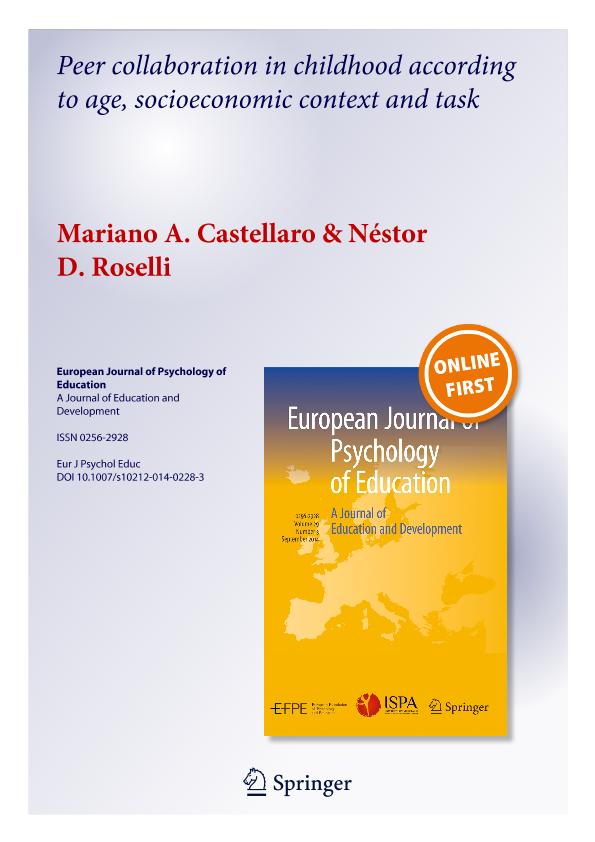Mostrar el registro sencillo del ítem
dc.contributor.author
Castellaro, Mariano Andrés

dc.contributor.author
Roselli, Nestor Daniel

dc.date.available
2017-01-05T13:40:41Z
dc.date.issued
2015-03
dc.identifier.citation
Castellaro, Mariano Andrés; Roselli, Nestor Daniel; Peer collaboration in childhood according to age, socioeconomic context and task; Springer; European Journal Of Psychology Of Education; 30; 1; 3-2015; 63-80
dc.identifier.issn
0256-2928
dc.identifier.uri
http://hdl.handle.net/11336/10860
dc.description.abstract
From a socio-constructivist approach, this work aimed to analyze the characteristics of peer collaboration in dyads of children according to age (4, 8, and 12 years old), socioeconomic context (advantaged socioeconomic context and disadvantaged socioeconomic context), and task (block construction task and free drawing). Eighty-two children (41 dyads) completed both collaborative tasks. Interaction was videotaped and transcribed in terms of verbal and non-verbal behaviors. Interaction was analyzed by a system of exhaustive and mutually exclusionary socio-behavioral categories. The results suggested that age group and task were related to the main differences in peer collaboration. On one hand, dissociation was a typical scene of 4-year-old dyads, whereas the more socially integrated categories, i.e., Implicit Cooperation, Explicit Cooperation, Collaboration and Conversation Related to Task without Execution, prevailed at 8 and 12 years old. On the other hand, differences associated with the task were referred with codes of higher social coordination. That is, the categories that not necessarily imply a distribution of functions on the basis of an oral agreement predominated in block construction task, as occurred in implicit cooperation and collaboration. In contrast, categories of verbal social regulation of roles (explicit cooperation or conversation related to task without execution) predominated in free drawing. Socioeconomic context influenced on fewer categories compared to the age group and task. The findings are discussed in terms of its developmental and contextual implications, and above all, in relation to the socio-behavioral level (regulated by verbalization) of collaborative interaction.
dc.format
application/pdf
dc.language.iso
eng
dc.publisher
Springer

dc.rights
info:eu-repo/semantics/openAccess
dc.rights.uri
https://creativecommons.org/licenses/by-nc-sa/2.5/ar/
dc.subject
Peer Collaboration
dc.subject
Collaborative Learning
dc.subject
Developmental Psychology
dc.subject
Socioeconomic Context
dc.subject
Task
dc.subject
Childhood
dc.subject.classification
Psicología

dc.subject.classification
Psicología

dc.subject.classification
CIENCIAS SOCIALES

dc.title
Peer collaboration in childhood according to age, socioeconomic context and task
dc.type
info:eu-repo/semantics/article
dc.type
info:ar-repo/semantics/artículo
dc.type
info:eu-repo/semantics/publishedVersion
dc.date.updated
2017-01-02T18:28:04Z
dc.identifier.eissn
1878-5174
dc.journal.volume
30
dc.journal.number
1
dc.journal.pagination
63-80
dc.journal.pais
Portugal

dc.journal.ciudad
Lisboa
dc.description.fil
Fil: Castellaro, Mariano Andrés. Consejo Nacional de Investigaciones Científicas y Técnicas. Centro Científico Tecnológico Rosario. Instituto Rosario de Investigaciones en Ciencias de la Educación; Argentina
dc.description.fil
Fil: Roselli, Nestor Daniel. Consejo Nacional de Investigaciones Científicas y Técnicas. Centro Científico Tecnológico Rosario. Instituto Rosario de Investigaciones en Ciencias de la Educación; Argentina
dc.journal.title
European Journal Of Psychology Of Education

dc.relation.alternativeid
info:eu-repo/semantics/altIdentifier/url/http://link.springer.com/article/10.1007/s10212-014-0228-3
dc.relation.alternativeid
info:eu-repo/semantics/altIdentifier/doi/http:/dx.doi.org/10.1007/s10212-014-0228-3
Archivos asociados
